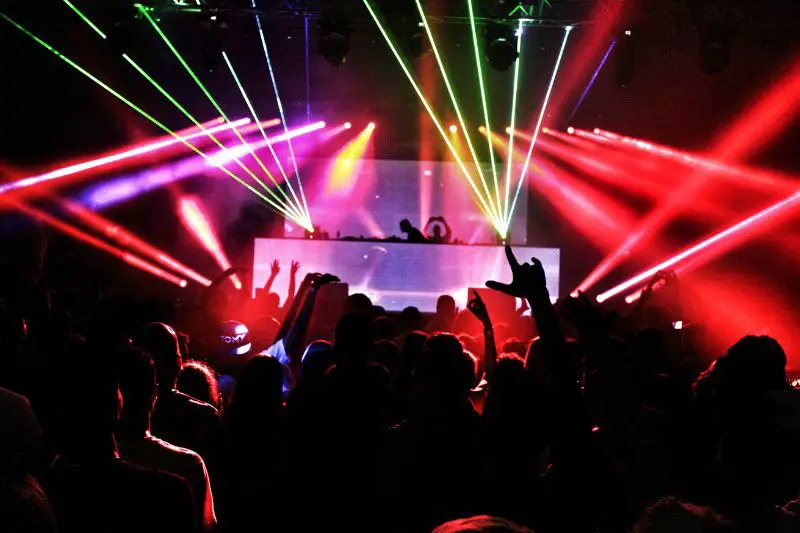
What makes a nightclub thrive in a competitive nightlife scene? It’s not just the music, the drinks, or the flashy lights—it’s the people who walk through the doors. Without the right crowd, even the most stylish club can struggle to survive.
Finding and attracting the ideal target market for nightclubs is the secret to long-term success. Whether you want to create an exclusive VIP lounge, a high-energy dance club, or a laid-back social spot, knowing your audience is key. But how do you pinpoint exactly who your ideal guests are? And more importantly, how do you make your club the place they want to be?
In this guide, we’ll break down everything you need to know about nightclub audiences—from demographics and psychographics to marketing strategies that will pack your venue with the right people. Get ready to discover how to identify, attract, and retain your perfect nightclub audience!
Understanding the Target Market for Nightclubs

Attracting the right audience is the foundation of a nightclub’s success. Without a well-defined target market, marketing efforts can feel like a shot in the dark—wasting time, money, and resources. To build a thriving venue, you need to understand who your ideal customers are, what they want, and how to reach them effectively.
Demographic Factors: Who Are Your Ideal Guests?
A nightclub’s audience varies based on several demographic elements:
- Age – Most nightclubs cater to young adults, typically between 18-35 years old. Different age groups have distinct nightlife preferences—college students seek affordability and high-energy events, while professionals often prefer upscale, exclusive experiences.
- Gender – While nightclubs should appeal to all, some brands market more towards specific genders, using promotions like ladies’ nights to encourage foot traffic.
- Income Level – A club’s pricing model (entry fees, drink prices, VIP sections) should align with the disposable income of its target audience. A luxury lounge attracts high-spending guests, whereas an affordable dance club appeals to budget-conscious partygoers.
- Location – Urban nightclubs often attract a mix of locals, tourists, and professionals, while suburban venues may focus more on community engagement.
Psychographic Factors: Understanding Lifestyles and Preferences
Beyond demographics, knowing your audience’s lifestyle, interests, and values helps in curating the perfect experience. Consider:
- Music Preferences – Hip-hop, EDM, Latin, jazz, or live performances? A nightclub’s music genre shapes its clientele.
- Social Habits – Some guests seek high-energy dance floors, while others prefer VIP lounges or cocktail bars with intimate seating.
- Spending Behavior – Are your patrons more likely to splurge on bottle service, or do they stick to budget-friendly drinks? Understanding their spending habits helps with pricing strategies.
Why Targeting Matters: The Risk of a “General” Approach
Trying to appeal to everyone often leads to attracting no one. A nightclub with an inconsistent atmosphere, mismatched music, and unclear branding confuses potential guests. Successful clubs have a clear identity, making them the go-to spot for a specific crowd.
By identifying and targeting the right market, you can craft memorable experiences, effective marketing campaigns, and a loyal customer base that keeps your nightclub buzzing night after night.
Types of Nightclub Audiences

Every nightclub attracts a specific crowd based on its music, atmosphere, pricing, and branding. Understanding the different types of audiences allows you to tailor your marketing strategies, event planning, and overall customer experience to meet their expectations. Below are some of the most common nightclub audiences and what appeals to them.
The Mainstream Party Crowd
This group represents the largest segment of nightclub-goers. They are typically young professionals and social enthusiasts looking for a fun night out.
- What they want: High-energy music, affordable drinks, and a vibrant dance floor.
- How to attract them: Promote popular DJs, themed party nights, and happy hour specials.
- Best marketing channels: Social media advertising, influencer promotions, and word-of-mouth buzz.
The VIP and High-Spending Clientele
Luxury seekers and affluent guests prefer exclusivity, premium services, and a refined nightlife experience. They frequent upscale clubs with bottle service, private sections, and top-tier entertainment.
- What they want: Personalized service, premium cocktails, and a sophisticated atmosphere.
- How to attract them: Offer VIP memberships, luxury experiences, and exclusive events.
- Best marketing channels: Direct outreach, luxury brand collaborations, and targeted ads to high-income demographics.
The College and Budget-Conscious Crowd
College students and younger guests are drawn to nightlife options that offer maximum fun without breaking the bank. They are highly social, making them valuable for generating organic word-of-mouth marketing.
- What they want: Low or no cover charges, drink specials, and themed events.
- How to attract them: Student discounts, free-entry nights, and social media engagement.
- Best marketing channels: TikTok, Instagram, and campus event sponsorships.
Niche Markets: Specialty and Theme-Based Audiences
Some nightclubs cater to specific interests, cultures, or music genres, building a dedicated and loyal following. These audiences may be smaller, but they are highly engaged.
- LGBTQ+ Clubs – Safe, inclusive spaces featuring drag shows, pride events, and diverse music styles.
- Latin Nightclubs – Salsa, bachata, and reggaeton enthusiasts looking for dance-focused venues.
- Techno & EDM Scenes – Electronic music lovers who seek top DJs, immersive lighting, and late-night events.
- What they want: Authentic experiences tailored to their specific interests.
- How to attract them: Booking niche artists, themed nights, and strong community engagement.
- Best marketing channels: Genre-specific influencers, community partnerships, and event-based promotions.
How to Identify Your Nightclub’s Target Market

Defining your nightclub’s target market requires more than guesswork. A strategic approach—rooted in data and market research—ensures that your business attracts the right audience and delivers an experience that keeps them coming back. Below are key steps to identifying your ideal customers.
Analyze Your Location and Competitor Landscape
The area where your nightclub operates plays a significant role in shaping your audience. Consider:
- Urban vs. Suburban Markets – City clubs tend to attract a diverse mix of professionals, tourists, and partygoers, while suburban venues may cater to locals seeking convenience and familiarity.
- Demographics of the Area – Study the income levels, age groups, and social habits of residents and visitors in your club’s location.
- Competitor Analysis – Visit other nightclubs nearby. Identify who they attract, what works well, and where gaps in the market exist. Are there underserved audiences you can target?
Gather Customer Data and Insights
Understanding your existing customer base helps refine your marketing strategy. Use:
- Point-of-Sale (POS) Data – Track spending habits, peak visiting hours, and popular drink or ticket purchases.
- Social Media Analytics – Platforms like Instagram and Facebook provide demographic insights on who engages with your content.
- Customer Surveys and Feedback – Ask guests about their preferences, favorite music, and what they would like to see more of in your venue.
Define Your Club’s Unique Selling Proposition (USP)
Your nightclub’s identity should align with the audience you want to attract. Consider:
- Music and Entertainment Style – Are you hosting live bands, EDM DJs, or Latin dance nights? The entertainment sets the tone for your crowd.
- Atmosphere and Theme – Upscale lounges with a dress code will attract different guests than casual, high-energy dance clubs.
- Pricing Strategy – Cover charges, bottle service, and drink pricing should reflect the income level of your ideal audience.
Test and Refine Your Marketing Strategy
After identifying your target market, continuously test and adapt your marketing efforts to ensure engagement.
- Trial Different Promotions – Offer themed nights, drink specials, or VIP events to see which audiences respond best.
- Monitor Attendance Trends – Track how different nights or promotions affect foot traffic and sales.
- Adjust Based on Feedback – Pay attention to online reviews, direct customer feedback, and social media engagement to fine-tune your approach.
Effective Marketing Strategies for Attracting Your Target Audience

Once you’ve identified your ideal nightclub audience, the next step is crafting a marketing strategy that effectively reaches and engages them. A targeted approach ensures your efforts are not only efficient but also impactful. Below are key strategies to draw in the right crowd.
Leverage Social Media and Influencer Marketing
Social media platforms are powerful tools for nightclub promotion. They allow you to engage with your audience, showcase events, and create viral buzz.
- Platform Selection – Instagram and TikTok are ideal for visual storytelling, while Facebook is useful for event promotions. Twitter can drive real-time engagement.
- Content Strategy – Post high-quality photos and videos of past events, exclusive behind-the-scenes content, and guest testimonials.
- Influencer Partnerships – Collaborate with local influencers and nightlife personalities to promote your club to their followers. Consider offering VIP experiences or sponsored posts in exchange for promotion.
Host Themed Events and Exclusive Nights
Special events can create anticipation and boost attendance, especially when tailored to your audience’s preferences.
- Theme Nights – Examples include 80s throwback parties, neon nights, Latin dance events, and luxury VIP evenings.
- Guest DJs and Live Performances – Booking well-known artists or DJs can generate excitement and attract their fan base.
- Loyalty and Membership Programs – Offer perks like free entry after multiple visits, exclusive discounts, or early access to event tickets.
Utilize Data-Driven Advertising
Targeted digital ads ensure you reach the right demographic efficiently.
- Facebook and Instagram Ads – Use audience targeting features to reach specific age groups, locations, and interests related to nightlife.
- Google Ads for Local Search – Optimize ads for “nightclubs near me” or similar search queries to capture those actively looking for a night out.
- Retargeting Campaigns – Re-engage past visitors by displaying ads to those who have interacted with your website or social media pages.
Engage with the Local Community
Building strong local connections can enhance your nightclub’s credibility and visibility.
- University and College Collaborations – Partner with student organizations for exclusive student nights or discounted entry.
- Business Partnerships – Work with nearby restaurants, hotels, and transportation services for cross-promotional deals.
- Local Event Sponsorships – Sponsor festivals, concerts, or charity events to increase brand awareness.
Optimize the Customer Experience
A great nightclub experience turns first-time guests into loyal patrons.
- Seamless Entry Process – Ensure fast, hassle-free entry by offering online ticketing and efficient door management.
- High-Quality Service – Train staff to provide excellent customer service, from bartenders to security personnel.
- Social Proof and Reviews – Encourage satisfied customers to leave positive reviews on Google, Yelp, and social media. User-generated content, such as tagged Instagram posts, can also boost credibility.
Adapting to Changing Trends in the Nightlife Industry

The nightclub industry is constantly evolving, influenced by shifting consumer preferences, technological advancements, and cultural changes. To stay competitive, nightclub owners must be adaptable and proactive in identifying and responding to these trends.
Embracing Technological Advancements
Technology is reshaping the nightclub experience, from digital marketing to in-club entertainment.
- Cashless and Mobile Payments – Many customers now prefer contactless payment options. Implementing mobile payment systems and digital wallets can enhance convenience and speed up transactions.
- Augmented Reality (AR) and Virtual Reality (VR) Experiences – Some clubs are incorporating AR/VR elements to create immersive experiences, such as interactive dance floors or themed virtual environments.
- AI-Driven Personalization – Advanced data analytics can help personalize promotions, suggest music preferences, and improve guest experiences based on past visits and behaviors.
Evolving Music and Entertainment Preferences
The music scene is dynamic, and understanding shifting trends is essential for maintaining a fresh and exciting club atmosphere.
- Genre-Specific Nights – Hosting nights dedicated to trending genres like Afrobeat, Latin, or deep house can attract niche audiences.
- Live Performances and Hybrid DJ Sets – Many nightclubs are incorporating live instrument performances alongside DJs to offer a unique and engaging experience.
- Interactive Entertainment – Clubs are introducing interactive elements like LED wristbands synchronized with music or AI-powered visual effects to elevate the atmosphere.
Sustainability and Social Responsibility
Eco-conscious consumers are pushing businesses to adopt sustainable practices, even in nightlife.
- Sustainable Drink Options – Offering organic cocktails, biodegradable straws, and locally sourced ingredients can appeal to environmentally aware patrons.
- Energy Efficiency – Implementing LED lighting, energy-efficient sound systems, and recycling programs can reduce the club’s environmental footprint.
- Socially Responsible Initiatives – Nightclubs partnering with local charities, supporting community projects, or promoting responsible drinking initiatives can build a positive brand image.
Shifts in Consumer Behavior and Preferences
The expectations of modern club-goers have changed, requiring venues to rethink their approach to customer engagement.
- Demand for Exclusive and Personalized Experiences – VIP sections, personalized bottle service, and member-only events are gaining popularity among high-spending clientele.
- Rise of Early-Night Clubbing – With wellness trends influencing nightlife, some clubs are shifting their peak hours earlier in the evening to cater to professionals and health-conscious guests.
- Focus on Social Media-Worthy Experiences – Creating visually appealing spaces with Instagrammable decor and unique aesthetics encourages guests to share their experiences online, boosting organic marketing.
Conclusion
Understanding and targeting the right market for your nightclub is essential for long-term success. By identifying key demographics, analyzing customer behaviors, and aligning your venue with evolving trends, you can create a space that consistently attracts and engages the right audience.
Successful nightclubs don’t just focus on entertainment—they craft unique experiences that cater to their patrons’ desires. Whether it’s through exclusive VIP services, immersive music events, or leveraging digital marketing strategies, staying adaptable and innovative is key.
Ultimately, a well-defined target market allows nightclub owners to make informed business decisions, optimize marketing efforts, and build a loyal customer base. By continuously assessing and refining your approach, you can ensure that your nightclub remains a go-to destination in an ever-changing industry.
